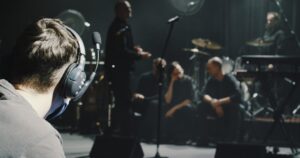World Hearing Day
- By Peter Byrom
- 03 March 2022
- 3 minutes 10:57am
Welcome back to the Peter Byrom Audiology blog and this month we are celebrating World Hearing Day (March 3rd). I wanted to shine a light on the work of the World Health Organisation (WHO) that focuses on how exposure to loud sounds can damage our hearing.
As the world gets back to normal, more and more of us will be attending concerts so this comes as a timely reminder to protect our hearing.
What’s the risk?
The WHO estimates that over one billion young people globally are at risk of hearing loss due to sound exposure in recreational settings. The risk of permanent hearing injury due to unsafe listening
is both avoidable and costly.
In the face of this growing threat, governments, public health agencies, those involved in the creation, distribution and amplification of music, the private sector, civil society, and other
stakeholders, all have a duty of care in understanding the sound levels to which audiences and consumers are being exposed and creating environments that facilitate safe listening behaviours.
What’s the answer?
To address this, WHO, as part of their Make Listening Safe initiative, developed the global standard for safe listening venues and events which provides a common understanding of safe listening in entertainment venues and events. The Standard comprises six features which, when implemented, allow audience members around the world to enjoy amplified music with the protection of their hearing, while also preserving the integrity of the artistic experience.
- Sound level limit: below 100 decibels. An upper limit of 100 dB is imposed, keeping sound safe and enjoyable for the audience
- Sound level monitoring: Live monitoring of sound levels is performed by a designated
staff member using calibrated equipment - System and acoustics: The sound system and venue acoustics are optimized ensuring safe listening
and improved sound quality - Personal hearing protection: hearing protection, such as earplugs, with appropriate instructions, are available to audience members
- Quiet zones: designated quiet spaces are available, allowing audience members to
rest their ears and thereby decrease the risk of hearing damage - Appropriate training and information: both audience members and staff are made aware of practical steps they can take to ensure safe listening

What can you do?
It may be some time before we start seeing initiatives like the above being implemented. In the meantime, we should all have an awareness of how loud sounds can damage our hearing. It might be that you take earplugs to the next concert you attend, or think, do I need to be so close to that speaker?!
What if the damage has been done?
If you think that you have already damaged your hearing through noise exposure, then Peter Byrom Audiology is here to help. Over the years I have helped several musicians but also those with work-related hearing loss from industrial environments. If you currently work in a noisy environment and need advice on hearing protection, do get in touch.
As always, if you think you may need an appointment I can be reached via the website or phone. I do hope that you enjoy the next concert you attend, just don’t forget to look after your ears!
Take care,
Peter
Services
Our Clinics
-
Byrom Audiology
Thornbury Hospital
312 Fulwood Road
Sheffield S10 3BR -
Byrom Audiology
12 Causeway Head Road Dore
Sheffield S17 3DT
0114 419 1800 - support-team@peterbyrom.co.uk


